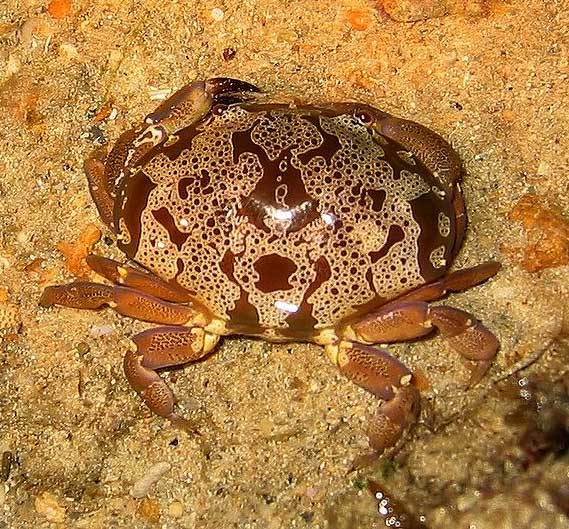
Atergatis floridus
Superregnum: Eukaryota
Cladus: Unikonta
Cladus: Opisthokonta
Cladus: Holozoa
Regnum: Animalia
Subregnum: Eumetazoa
Cladus: Bilateria
Cladus: Nephrozoa
Cladus: Protostomia
Cladus: Ecdysozoa
Cladus: Panarthropoda
Phylum: Arthropoda
Cladus: Pancrustacea
Superclassis: Multicrustacea
Classis: Malacostraca
Subclassis: Eumalacostraca
Superordo: Eucarida
Ordo: Decapoda
Subordo: Pleocyemata
Infraordo: Brachyura
Sectio: Eubrachyura
Subsectio: Heterotremata
Superfamilia: Xanthoidea
Familia: Xanthidae
Subfamilia: Zosiminae
Genus: Atergatis
Species: Atergatis floridus
Name
Atergatis floridus (Linnaeus, 1767)
Vernacular names
日本語: スベスベマンジュウガニ
Atergatis floridus, the floral egg crab, green egg crab, pancake crab, or shawl crab, is a species of tropical Indo-Pacific crab from the family Xanthidae. The meat of this crab is toxic, even if cooked, and consumption often results in death.
Description
Atergatis floridus has an oval, relatively narrow carapace which has a smooth surface and smooth margins. The carapace is greenish or greenish-blue-brown and is marked with a pattern which resembles lace and is made up of a fine network of fine white or yellow lines white, resembling a shawl. It has large claws which are equal sizes and which are smooth with black spoon-shaped tips and which may be larger in males than females. The pereiopods are squarish in shape and quite thick with lilac edges and lack hair. The width of the carapace is 8–10 cm (3.1–3.9 in).[2] The carapace is approximately 1.4 times broader than it is long.[3]
Distribution
Atergatis floridus occurs in the eastern Indian Ocean from south east Asia, south to Australia where it reaches Rottnest Island in Western Australia and possibly Sydney in the east, its range extends eastwards across the western pacific as far as Hawaii.[3][4][5][6]
Biology
Atergatis floridus is an inhabitant of the neritic zone and prefers coral and rubble.[7] It is largely nocturnal.[2] A. floridus is host to the isopod Gigantione hainanensis and the rhizocephalan barnacles Loxothylacus aristatus, Loxothylacus corculum, Sacculina gordonae, Sacculina robusta, Sacculina spinosa and Sacculina weberi.[1][8]
Toxicity
The meat of Atergatis floridus, like that of many related crab species from the family Xanthidae is toxic. The toxins are synthesised by bacteria of the genus Vibrio which live in symbiosis with the crab and the poisons are one similar to those found in puffer fish, i.e. tetrodotoxin, and also saxitoxin which is the primary toxin involved in paralytic shellfish poisoning.[9][6]
Taxonomy
Atergatis floridus was considered to have a wide Indo-Pacific distribution but some authorities consider that the western Indian Ocean specimens belong to a different species, Atergatis ocryoe, which was considered a junior synonym of A. floridus. A. floridus sensu stricto is found in the eastern Indian Ocean and Western Pacific.[4]
References
P. Davie (2015). "Atergatis floridus (Linnaeus, 1767)". World Register of Marine Species. Retrieved 23 January 2017.
"Floral egg crab". Wild Singapore. wildfactsheets. Retrieved 23 January 2017.
K. Sakai. "Atergatis floridus". Marine Species Identification Portal: Crabs of Japan. ETI Bioinformatics. Retrieved 23 January 2017.
Peter K.L. Ng; Peter J.F. Davie (2007). "On the identity of Atergatis floridus (Linnaeus, 1767) and recognition of Atergatis ocyroe (Herbst, 1901) as a valid species from the Indian Ocean (Crustacea: Brachyura: Xanthidae)" (PDF). Raffles Bulletin of Zoology. Supplement No. 16: 169–175. Archived from the original (PDF) on 2017-02-02. Retrieved 2017-01-23.
Gary C. B. Poore (2004). Marine Decapod Crustacea of Southern Australia: A Guide to Identification. CSIRO Publishing. p. 477. ISBN 0643069062.
"Creature Feature – Toxic Crabs". Western Australian Museum. Retrieved 23 January 2017.
M.L.D. Palomares; D. Pauly, eds. (2016). "Atergatis floridus". Sea Life Base. Retrieved 23 January 2017.
H. Boschma (1948). "The Rhizocephalan parasites of the crab Atergatis floridus (L.)" (PDF). Proceedings of the Koninklijke Nederlandse Akademie van Wetenschappen. 51: 515–524.
Tamao Noguchi; Joong-Kyun Jeung; Osamu Arakawa; et al. (1985). "Occurrence of tetrodotoxin and anhydrotetrodotoxin in Vibrio sp. isolated from the intestines of a xanthid crab, Atergatis floridus". Journal of Biochemistry. 99 (1): 311–314. doi:10.1093/oxfordjournals.jbchem.a135476. PMID 3754255.
Retrieved from "http://en.wikipedia.org/"
All text is available under the terms of the GNU Free Documentation License

